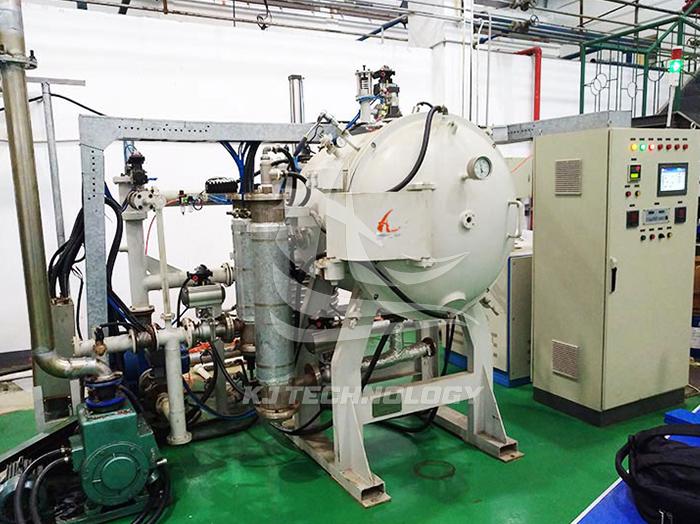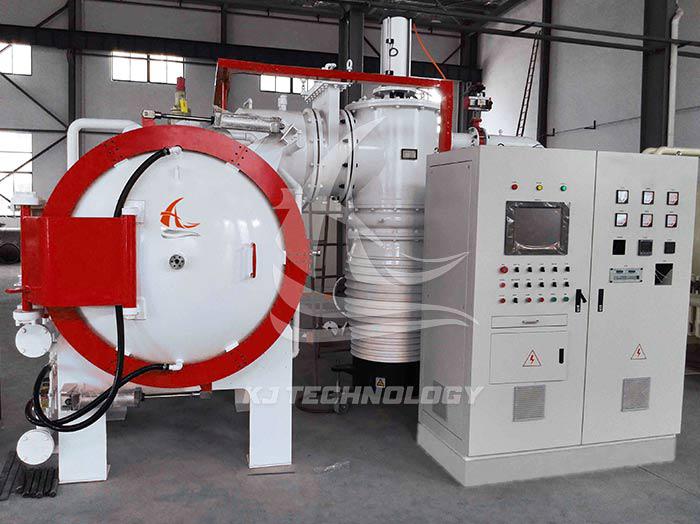Can the vacuum furnace for heat treatment be filled with atmosphere?
 09-11-2025 Author: KJ technology
09-11-2025 Author: KJ technology
Heat treatment vacuum furnaces can be filled with an atmosphere, and by introducing specific gases (known as "atmospheres"), their process functions can be significantly expanded to meet diverse material processing needs. Here is a detailed analysis:
1. Principle of passing atmosphere in heat treatment vacuum furnace
The synergistic effect of vacuum and atmosphere
The vacuum furnace reduces the pressure inside the furnace to an extremely low level (usually ≤ 10 ⁻ ³ Pa) through a vacuum pump, and then introduces high-purity gases (such as nitrogen, argon, hydrogen, methane, etc.) according to process requirements to form a controllable "vacuum+atmosphere" environment. The gas flow rate, pressure, and composition can be precisely regulated through mass flow meters (MFCs) and pressure sensors.
Gas selection criteria
Inert gases (N ₂, Ar): used to protect the surface of materials, prevent oxidation or decarburization, and also serve as cooling media (such as high-pressure gas quenching).
Reductive gas (H ₂): used for deoxidation, reduction of metal oxides, or as a carrier for carburizing/nitriding.
Carbon source gas (CH ₄, C ₂ H ₂): used in vacuum carburizing process to form a high hardness carbide layer on the metal surface.
Nitrogen source gases (NH ∝, N ₂): used for vacuum nitriding or nitrogen carbon co nitriding to enhance material wear resistance.
2. The core advantages of atmospheric technology
Breaking through the limitations of a single vacuum environment
Vacuum carburizing: Introducing methane (CH ₄) under low pressure environment improves the carbon atom permeation efficiency compared to traditional gas carburizing, and the surface carbon concentration gradient is smoother, reducing the deformation of the workpiece.
Vacuum brazing: Introducing hydrogen gas (H ₂) as a reducing agent can remove surface oxides of the base material, improve brazing strength, and reduce leakage rate.
Implement composite heat treatment process
Vacuum+high-pressure gas quenching: During the quenching stage, high-pressure nitrogen gas (20 bar) is introduced at a cooling rate of 50 ℃/s to increase the hardness of high-speed steel while avoiding oil quenching pollution.
Vacuum+ion nitriding: Applying a direct current electric field inside the furnace to ionize nitrogen gas into plasma, increasing the depth of the nitriding layer, improving hardness, and enhancing wear resistance.
Accurately control the surface composition of materials
Vacuum carbonitriding: A mixed gas of methane (CH4) and ammonia (NH3) is introduced to form a compound layer containing carbon and nitrogen on the metal surface, which improves the anti bite performance.
Vacuum degassing+aluminum infiltration: First, hydrogen gas is introduced to remove the internal hydrogen gas of the material, and then aluminum vapor is introduced for surface aluminum infiltration, forming a dense aluminum oxide protective layer and improving corrosion resistance.
3. Typical application scenarios
aerospace field
Surface treatment of titanium alloy: Vacuum annealing is carried out under the protection of argon gas (Ar) to eliminate processing stress, and then nitrogen gas (N ₂) is introduced for ion nitriding, resulting in higher surface hardness and extended wear resistance life.
High temperature alloy blade strengthening: Propane (C ∝ H ₈) is introduced into the vacuum carburizing process to control the surface carbon concentration within a small range, and the oxidation resistance is improved at a high temperature of 1000 ℃.
Automotive manufacturing field
Gear vacuum carburizing: Acetylene (C ₂ H ₂) is introduced as a carbon source and carburized at 930 ℃ for 4 hours. The surface hardness increases, the core hardness improves, and the deformation is smaller. It replaces the traditional carburizing+oil quenching process and improves the yield rate.
Surface modification of mold steel: Vacuum nitrogen carbon co diffusion is carried out by introducing ammonia gas (NH3), which improves the life of the mold and reduces maintenance costs.
Semiconductor and Electronics Industry
Chip packaging vacuum brazing: high-purity hydrogen gas (H ₂, 99.999%) is introduced to reduce the oxide film, improve the wetting properties of the brazing material, reduce the porosity of the weld seam, and meet the high reliability requirements of 5G communication devices.
Annealing of magnetic materials: Nitrogen (N ₂) is introduced under vacuum environment for protection, which improves the coercivity (Hc) and remanence (Br) stability of neodymium iron boron permanent magnets.
4. Technical Challenges and Solutions
Gas purity control
Challenge: Impurities in gases (such as O ₂, H ₂ O) can cause surface oxidation or hydrogen embrittlement of materials.
Solution: Adopt high-purity gas (≥ 99.999%) and furnace cold trap adsorption device, with controllable oxygen production content below a certain value.
Uniformity of atmosphere
Challenge: Uneven gas flow can lead to differences in the surface treatment effect of workpieces.
Solution: Optimize the gas circulation system inside the furnace (such as porous nozzles+forced convection fans) to ensure temperature field and atmosphere uniformity.
Security risk prevention and control
Challenge: Flammable gases such as hydrogen pose a risk of explosion.
Solution: Install a hydrogen concentration monitoring and alarm system, explosion-proof valve, and automatic emergency shut-off device to ensure safe operation.
5. Industry Development Trends
Intelligent atmosphere control
Real time adjustment of gas flow rate and pressure through AI algorithms, for example, a certain vacuum furnace uses machine learning models to optimize the carburizing process, improving the accuracy of carbon concentration control.
Multi functional atmosphere integration
Develop a "vacuum+multiple atmosphere" composite furnace, which simultaneously introduces nitrogen, methane, and ammonia to achieve an integrated process of carbon nitrogen co diffusion and deoxygenation, reducing processing time.
Green Atmosphere Technology
Using refrigerants with low global warming potential (GWP) instead of traditional hydrogen, such as propane (C ∝ H ₈) as the carburizing gas, reduces carbon emissions.








